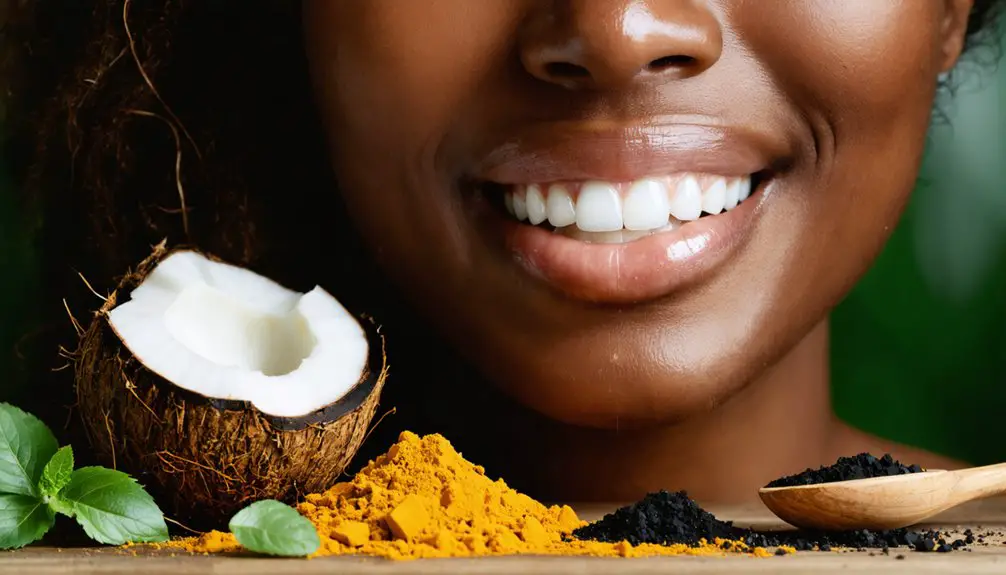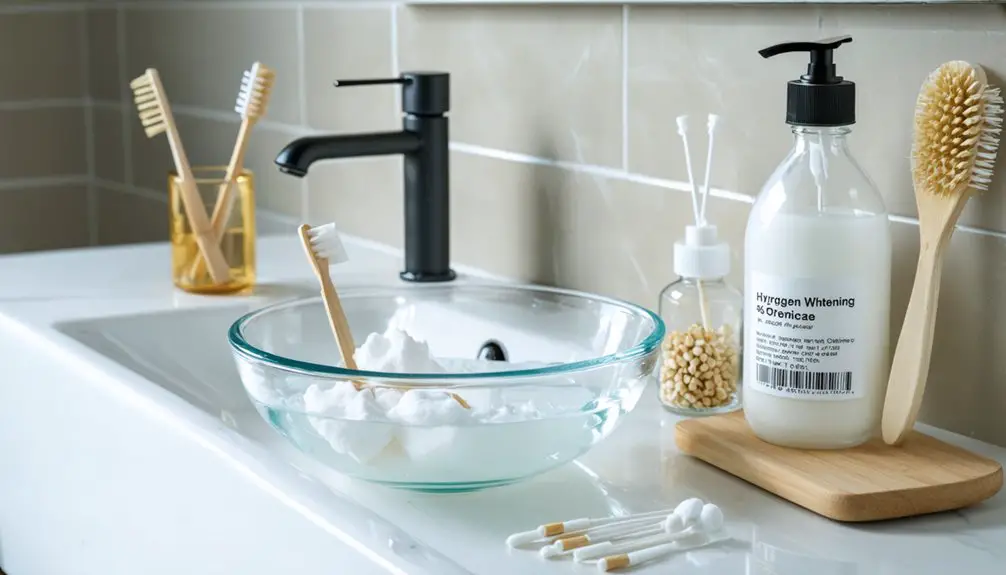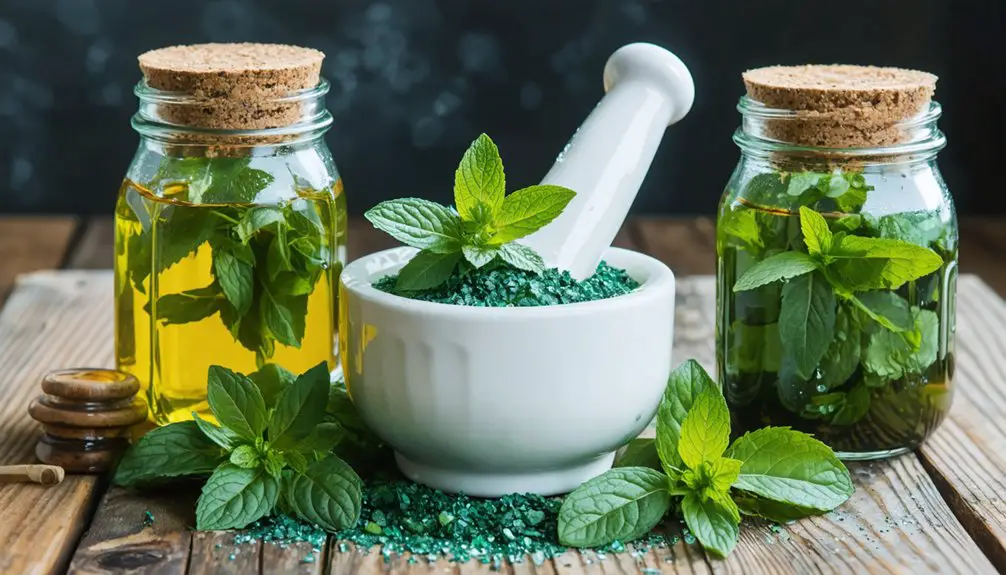You can naturally whiten your teeth using safe, organic methods like oil pulling with coconut oil, gentle brushing with baking soda, or applying enzyme-rich fruits like pineapple and papaya. Combine these treatments with smart daily habits – drink staining beverages through a straw, rinse with water after meals, and eat crunchy produce that naturally scrubs teeth. For the brightest smile, discover how traditional remedies and prevention strategies work together to enhance your results.
Key Takeaways
- Oil pulling with coconut oil for 15-20 minutes daily helps remove surface stains and naturally whitens teeth through gentle detoxification.
- Mix baking soda with hydrogen peroxide to create a mild whitening paste that safely removes surface stains while protecting enamel.
- Consume enzyme-rich fruits like pineapple and papaya, which contain natural whitening properties and help break down stain molecules.
- Brush with activated charcoal powder once weekly to effectively bind to and remove surface stains from teeth.
- Eat crunchy raw vegetables and fruits, which naturally scrub teeth while providing nutrients that support oral health.
Understanding Natural Teeth Whitening: Science and Safety
While many people seek brighter smiles through natural methods, understanding the science behind teeth whitening is vital for achieving safe and effective results.
Natural remedies work through different mechanisms – some use gentle oxidation to break down stain molecules, while others rely on mild abrasive action to remove surface discoloration. The process often targets both external and deep internal stains that develop below the enamel surface.
Natural whitening relies on two main processes: oxidation to break down stains and gentle abrasives to lift surface discoloration.
When you’re exploring natural whitening options, it’s important to understand the chemical interactions taking place in your mouth. Your teeth’s enamel is precious and can be damaged by overly acidic or abrasive substances. Experts note that chromogens break down during oxidation processes to achieve lighter tooth coloring.
Even natural ingredients like lemon juice can erode enamel over time. The key is finding balance – you’ll want treatments that are effective enough to brighten your smile but gentle enough to protect your enamel’s integrity.
Consider consulting a dental professional to guarantee your chosen natural whitening method supports long-term oral health.
Top Organic Ingredients for a Brighter Smile
You’ll find powerful whitening ingredients right in your kitchen, including enzyme-rich pineapple, papaya, and natural cleansers like baking soda.
While coconut oil pulling and turmeric have gained popularity for their gentle approach to dental care, enzymatic options like bromelain and papain offer scientifically-backed whitening potential without harsh chemicals.
When choosing natural whitening methods, it’s crucial to avoid acidic ingredients like lemon juice that can damage your enamel, and instead focus on safe alternatives that protect your tooth health while gradually improving brightness.
Activated charcoal can effectively bind to and remove surface stains on teeth when used properly.
Research shows these natural ingredients are non-cytotoxic to cells while providing effective whitening results.
Safe Whitening Kitchen Staples
Looking to brighten your smile without harsh chemicals? Your kitchen likely contains safe, natural ingredients that can help whiten your teeth effectively.
Many people prefer organic methods because they offer eco-friendly alternatives to commercial whitening products.
The natural combination works well for removing stains from coffee and tea consumption.
Baking soda combined with hydrogen peroxide creates a gentle yet powerful whitening paste that’s perfect for removing surface stains. When used a few times weekly, this combination helps maintain a brighter smile while protecting your enamel.
- Mix 1 teaspoon of baking soda with enough hydrogen peroxide to form a paste
- Apply the mixture gently with a soft toothbrush for 2 minutes
- Rinse thoroughly and follow with your regular oral care routine
Remember to use these natural whiteners in moderation. While they’re effective for removing stains, overuse can lead to sensitivity.
Natural Stain Fighting Ingredients
Nature provides an impressive array of organic ingredients that can effectively combat tooth stains and promote a brighter smile. You’ll find powerful stain-fighting properties in activated charcoal‘s natural exfoliation abilities, while strawberries offer malic acid that helps prevent new discoloration. Experts recommend focusing on proven whitening methods instead of charcoal due to limited research on its safety.
Coconut oil’s antimicrobial effects through oil pulling can reduce bacteria that cause staining, making it a gentle daily option. Adding crunchy raw produce to your diet naturally scrubs teeth while you eat.
Consider the dietary influences of sulfur-rich vegetables like onions, which create natural barriers against plaque formation. For mechanical stain removal, nuts and seeds provide textured surfaces that help clean your teeth while stimulating saliva production.
These natural ingredients work together to support your oral health journey, offering a holistic approach to maintaining white teeth without harsh chemicals.
Step-by-Step Guide to Oil Pulling
Following three simple steps will help you master the ancient practice of oil pulling, a natural method that may support oral health and potentially contribute to whiter teeth. The practice dates back approximately 2,500 years in traditional medicine.
Begin by measuring one tablespoon of coconut, sesame, or olive oil. Coconut oil’s natural antimicrobial properties make it an excellent choice for this oral hygiene ritual. This traditional Indian remedy has been used for generations to promote dental wellness.
Coconut oil stands out as a prime choice for oil pulling, thanks to its powerful antimicrobial qualities that enhance this time-tested practice.
- Gently swish the oil around your mouth for 15-20 minutes, though you can start with 5-10 minutes as a beginner.
- Avoid swallowing the oil since it contains bacteria and toxins collected during the process.
- Spit the oil into the trash (not sink), then rinse thoroughly with water before eating or drinking.
For best results, practice oil pulling on an empty stomach, preferably first thing in the morning, and use a fresh toothbrush afterward to prevent bacterial reintroduction.
Safe Application Methods for Natural Whiteners
You’ll achieve the best whitening results by combining gentle natural methods like baking soda with your regular fluoride toothpaste, rather than using harsh treatments that can damage your enamel.
When using hydrogen peroxide, limit applications to once or twice weekly and always dilute it properly to protect your teeth’s sensitivity and overall health.
For consistent and safe results, complement these natural whiteners with teeth-friendly foods like raw vegetables while maintaining proper brushing and flossing techniques.
Recommended Application Techniques
Successful natural teeth whitening depends heavily on proper application techniques to guarantee both safety and effectiveness. When using natural abrasives like baking soda or fruit enzymes, you’ll want to be gentle and methodical in your approach.
Apply whitening pastes with a soft-bristled brush using light circular motions, and never scrub aggressively to protect your enamel.
- Mix your natural whitening pastes fresh before each use, combining ingredients like strawberries with baking soda or coconut oil until smooth.
- Time your treatments carefully – 2 minutes for baking soda mixtures, 5 minutes for fruit-based pastes, and 15-20 minutes for oil pulling.
- Always rinse thoroughly after treatments and follow up with regular brushing to remove any residual acids or compounds.
Balancing Safety With Results
While natural teeth whitening can deliver impressive results, it’s vital to prioritize safety alongside effectiveness to protect your oral health.
When using natural remedies, always opt for pH-neutral or slightly alkaline solutions rather than acidic ones like lemon juice, which can permanently damage your enamel.
Take essential safety precautions by limiting the frequency and duration of whitening treatments. If you notice increased tooth sensitivity or gum irritation, stop treatment immediately.
For those with dental restorations, seek professional guidance before starting any whitening regime. Consider supplementing your whitening routine with fluoride-containing products to help remineralize your teeth.
Benefits and Risks of Common Kitchen Remedies
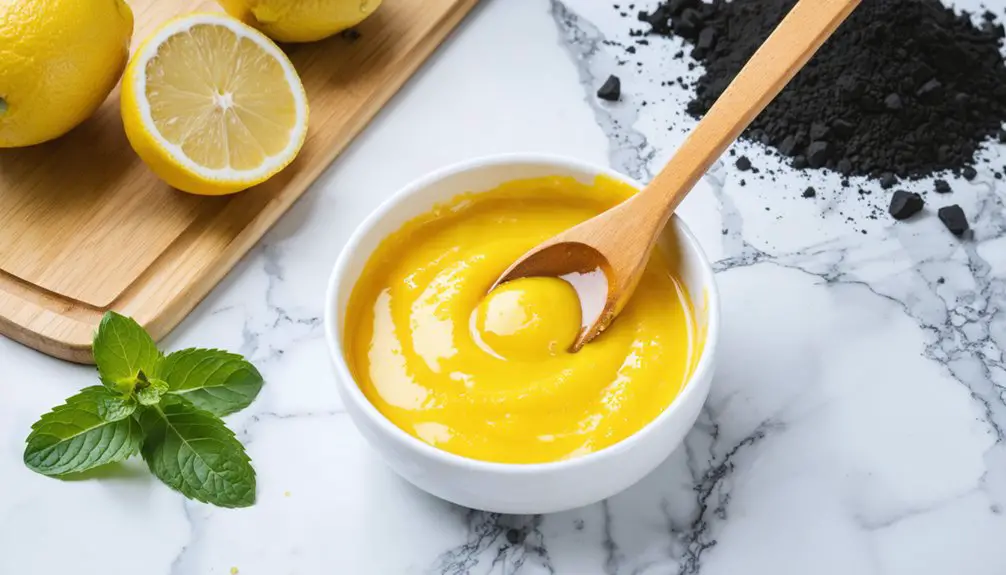
Many people seeking natural alternatives to commercial teeth whitening products turn to common kitchen ingredients, but it’s essential to understand both their benefits and potential risks.
While natural remedies like baking soda offer gentle whitening effects when used moderately, harsh ingredients such as lemon juice can severely damage your enamel.
Oil pulling with coconut oil provides a safe daily option, though results may take longer to achieve.
- Baking soda mixed with hydrogen peroxide creates an effective whitening paste, but limit use to 10 minutes daily for two weeks.
- Choose crunchy fruits and vegetables that naturally clean teeth while stimulating protective saliva production.
- Replace acidic fruit-based remedies with coconut oil pulling to protect your enamel while improving oral health.
Creating Your Own Organic Whitening Paste
Creating your own organic whitening paste lets you take control of your dental care while avoiding harsh chemicals found in commercial products.
You’ll need basic ingredients like coconut oil, baking soda, and optional hydrogen peroxide to make your homemade toothpaste effective and safe.
Start by mixing coconut oil with a small amount of baking soda until you achieve a smooth consistency. For natural flavors, consider adding a drop of peppermint essential oil or stevia.
If you’re using hydrogen peroxide, add it sparingly and store your mixture in a dark container to maintain its effectiveness.
Remember to consult your dentist before starting any new dental care routine.
Store your mixture in an airtight container in a cool place, and use it within two weeks for best results.
Daily Habits for Maintaining White Teeth
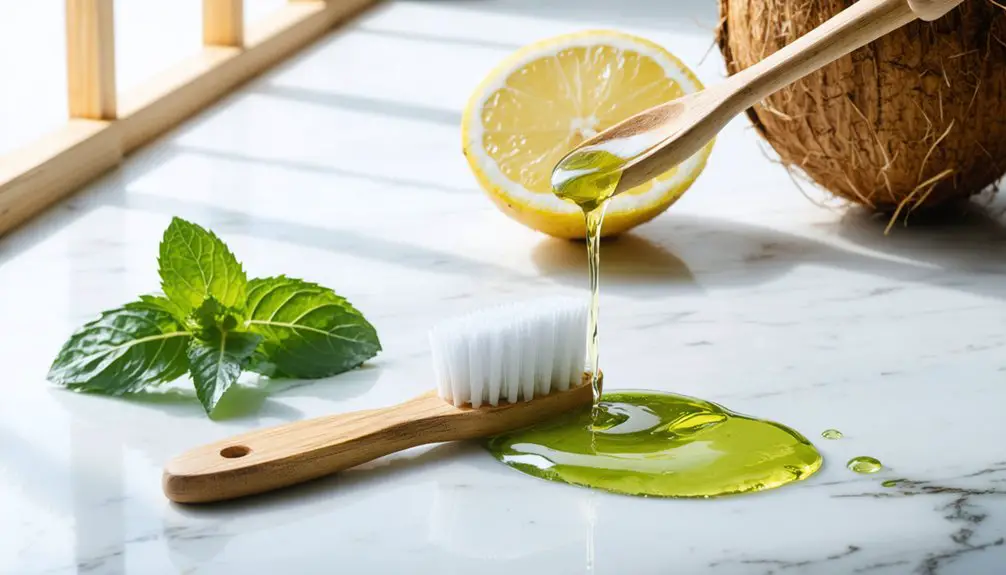
To maintain naturally white teeth, you’ll need to develop consistent daily habits that protect your smile from stains and discoloration.
Daily flossing removes trapped particles that can lead to yellowing, while staying hydrated through regular water consumption helps naturally cleanse your teeth throughout the day.
When consuming staining beverages like coffee or tea, use a straw to minimize contact with your teeth and rinse afterward with water.
- Brush with fluoride toothpaste twice daily, waiting at least 30 minutes after acidic foods to protect your enamel
- Practice oil pulling with coconut or sesame oil first thing in the morning to help remove surface stains
- Boost hydration benefits by swishing water in your mouth after meals when you can’t brush immediately
Time-Tested Traditional Whitening Methods
You can enhance your smile naturally through oil pulling, an ancient Ayurvedic practice that involves swishing coconut or sesame oil in your mouth for up to 20 minutes to reduce bacteria and lighten teeth.
When you’re looking for gentle yet effective whitening, baking soda offers a time-tested solution that’s both safe and naturally abrasive enough to lift surface stains.
These traditional methods align perfectly with a chemical-free approach to oral care, letting you achieve whiter teeth while maintaining the integrity of your tooth enamel.
Ancient Oil Pulling Techniques
While modern teeth whitening solutions flood the market, oil pulling stands as an ancient Ayurvedic practice that has brightened smiles for over 3,000 years. This time-tested technique involves swishing oil, particularly coconut oil, in your mouth for 15-20 minutes to naturally enhance oral health.
The mechanical action of swishing combined with coconut oil’s antimicrobial properties helps remove plaque, reduce harmful bacteria, and potentially lighten tooth stains.
- Use 1 teaspoon to 1 tablespoon of coconut oil, swishing vigorously between your teeth
- Continue for 15-20 minutes (or 5 minutes if you’re just starting out)
- Always spit the oil into the trash, not your sink, to prevent clogging
While oil pulling shouldn’t replace brushing and flossing, it serves as a gentle, chemical-free complement to your daily dental routine, offering both whitening and oral health benefits.
Safe Baking Soda Methods
Although baking soda has brightened smiles for generations, using it safely requires the right approach to protect your tooth enamel.
To create a gentle whitening paste, mix one teaspoon of baking soda with enough water to form a smooth consistency. Apply this mixture with a soft-bristled brush using light, circular motions for just 1-2 minutes.
Important baking soda precautions include limiting whitening frequency to once every two weeks, or at most twice weekly. Always rinse thoroughly and avoid swallowing the paste.
While this natural method effectively removes surface stains, it won’t address deeper discoloration like professional treatments do. Consider alternating with fluoride toothpaste to maintain peak oral health.
When used properly, this time-tested remedy offers a budget-friendly way to brighten your smile while preserving your enamel’s integrity.
Combining Natural Agents for Better Results
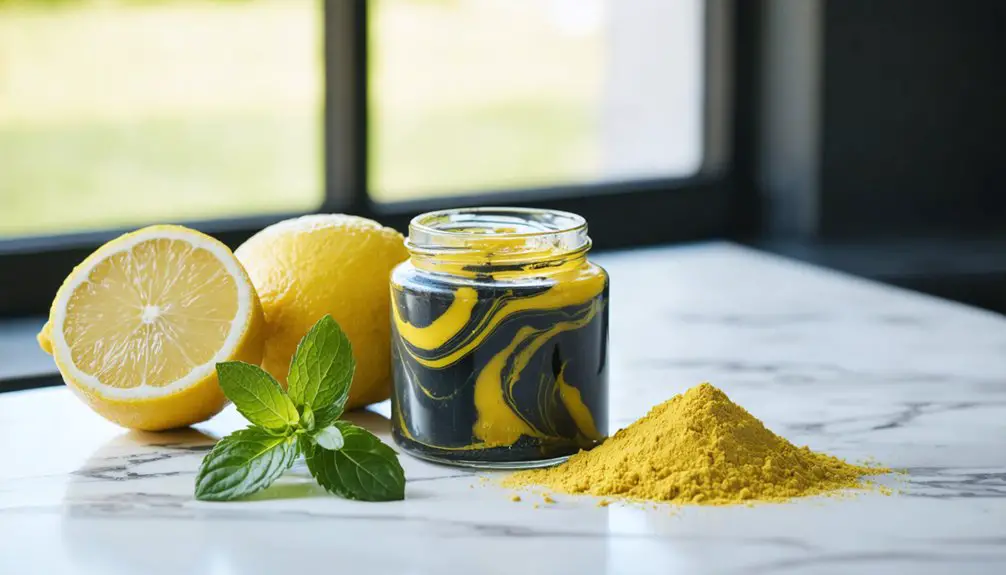
Combining natural whitening agents can amplify your teeth-brightening results while maintaining a gentle, holistic approach to oral care.
When you pair mild natural abrasives like baking soda with hydrogen peroxide, you’ll create a whitening synergy that’s more effective than using either ingredient alone. This combination helps lift surface stains while naturally bleaching deeper discoloration.
- Mix activated charcoal with baking soda for enhanced stain removal, but use sparingly to protect your enamel.
- Supplement your brushing routine with calcium-rich foods and crunchy vegetables to strengthen teeth while fighting stains.
- Consider gentle fruit enzymes paired with natural abrasives, but avoid acidic combinations that could damage enamel.
Remember to use these combinations in moderation, as even natural ingredients can be powerful when working together.
Prevention Tips to Avoid Tooth Discoloration
Natural teeth whitening works best when paired with smart prevention strategies. You’ll want to focus on daily preventive measures that protect your smile’s natural brightness.
Start by adopting mindful dietary habits – use a straw for staining beverages, rinse with water after consuming pigmented foods, and chew sugar-free gum to stimulate cleansing saliva flow.
Maintain gentle but thorough oral care using soft-bristled brushes and natural toothpaste. Include tongue cleaning in your routine to reduce bacteria that can cause discoloration.
Stay well-hydrated and embrace foods that naturally cleanse your teeth. If you use tobacco products, consider quitting not just for whiter teeth, but for your overall wellness.
Remember that prevention is always easier than correction when it comes to maintaining your smile’s natural radiance.
Frequently Asked Questions
Can Pregnant Women Safely Use Natural Teeth Whitening Methods?
You’ll want to be cautious with any whitening during pregnancy, but gentle organic ingredients like baking soda or strawberry paste can be safe when you’ve gotten your dentist’s approval for dental safety.
How Long Should I Wait After Eating Before Applying Natural Whitening Agents?
For ideal timing recommendations, you’ll want to wait 30 minutes after eating to apply natural whitening agents. This allows your saliva to neutralize acids and restore proper pH balance.
Will Natural Whitening Methods Affect Tooth-Colored Fillings or Dental Crowns?
Natural whitening won’t change your fillings or crowns’ color, potentially creating uneven results. While these methods won’t affect filling durability or cause tooth sensitivity, you’ll need professional help matching restorations afterward.
Does Drinking Through a Straw Prevent Natural Whiteners From Staining Teeth?
You’ll get partial staining prevention benefits from straws, but they won’t completely block natural whiteners’ effects. Position your straw behind your teeth for best results in reducing contact.
Can Children Use Organic Teeth Whitening Methods Safely?
For child dental safety, it’s best to avoid organic whitening methods until age 18. Even natural treatments can harm developing teeth, so consult a pediatric dentist first.
References
- https://pmc.ncbi.nlm.nih.gov/articles/PMC10024105/
- https://pmc.ncbi.nlm.nih.gov/articles/PMC4058574/
- https://chestnutdental.com/blog/are-natural-teeth-whitening-methods-safe-and-effective/
- https://www.thompsondentalatnora.com/natural-vs-commercial-a-deep-dive-into-different-teeth-whitening-techniques/
- https://newsnetwork.mayoclinic.org/discussion/mayo-clinic-q-and-a-many-safe-choices-available-to-help-whiten-teeth/
- https://cosmeticdentistryofsa.com/the-science-behind-teeth-whitening/
- https://sandlakedental.com/blog/understanding-the-science-behind-teeth-whitening/
- https://www.evergreendentalgroup.com/the-art-and-science-of-teeth-whitening/
- https://www.todaysrdh.com/study-shows-natural-tooth-whiteners-as-effective-as-peroxide-whiteners/
- https://www.trysnow.com/blogs/news/teeth-whitening-ingredients
